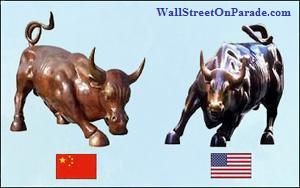By Pam Martens: July 14, 2015
Remember the Super SIV, also known as the Master Liquidity Enhancement Conduit or MLEC? That was a 2007 scheme in the U.S. to create a toxic waste dump where banks could stuff all their bad debts and instantly repair their balance sheets. It didn’t fly, leaving the Federal Reserve, Treasury Department and Federal Deposit Insurance Corp. to come up with a raft of programs during the 2008 crisis to buy up, guarantee or ring fence hundreds of billions of dollars in bad bank debt. That effort was further enhanced with $13 trillion in secret, super cheap loans to Wall Street and foreign banks by the Federal Reserve.
This produced a dystopian landscape on Wall Street, with Citigroup trading at 99 cents a share during the panic, Lehman Brothers and Bear Stearns collapsed, AIG, Fannie Mae and Freddie Mac wards of the government, and Merrill Lynch, Washington Mutual and Wachovia succumbing to shot-gun marriages.
China had an equally problematic idea of how to deal with bad bank debts back in 1999 and the fingerprints of Wall Street’s biggest banks are all over that plan today. Given how Wall Street handled its own affairs in the lead up to the crash of 2008, its meddling in China’s bad debt situation today should not be comforting to anyone.
Back in 1999, China set up four asset-management companies (known as AMCs) to hold the non-performing loans of the four biggest banks in China. The state took a majority stake in each. The four AMCs oversaw $229 billion in nonperforming loans, effectively making them the “bad bank” portion of their related bank. China Cinda Asset Management took on the bad debts of China Construction Bank; China Huarong took bad debt from Industrial and Commercial Bank of China; China Great Wall Asset Management Corp. worked with Agricultural Bank of China and China Orient Asset Management Corp. worked with Bank of China. The government gave each distressed asset management company 10 billion yuan of capital and a 10-year period to dispose of assets.
In 2013, China Cinda was the first of the AMCs to go public, listing its IPO on the Hong Kong stock exchange. Here’s how Goldman Sachs, an underwriter of the deal, explains the offering on its web site:
“Goldman Sachs has played a central role in introducing Chinese companies to international equity capital markets. In 2013 we helped nine China-based companies collectively raise $8.8 billion through IPOs on the Hong Kong Stock Exchange. The firm was joint global coordinator, sponsor and book runner for China Cinda Asset Management Company’s (China Cinda) $2.8 billion IPO, in which it became the first Chinese distressed asset management company to go public. The offering prompted high demand in Hong Kong — the stock closed up 26 percent on its first day of trading, the best debut performance among Hong Kong financial institutions IPOs since 2004.”
Tom Holland, a financial writer for the South China Morning Post, had some different thoughts on the deal at the time, headlining his article: “China’s Insolvent Toxic-Waste Dump Cinda for Sale.” Holland said that “by any sensible standards,” all four of the AMCs “are insolvent.” Holland went on to explain what evolved after their creation in 1999:
“Over the next five years, the four asset management companies bought some two trillion yuan in non-performing assets in three successive waves. Most of these assets were purchased at face value, with the asset management companies paying for their purchases by issuing bonds — bonds which were bought by the state banks.
“Under the original plan, the asset management companies were meant to recover the value of the assets over 10 years, repaying the principal on their bonds at maturity in 2009…
“In Red Capitalism, a 2011 study of the mainland financial system, Carl Walter and Fraser Howie estimated that by 2008 the asset management companies were sitting on nearly 1.5 trillion yuan in unrecognised write-downs.”
Chinese government authorities restructured the bonds in 2009 and again in 2010, pushing forward the day of reckoning. Holland says: “Offsetting the liability of their bonds, their assets now consist largely of what amount to IOUs from the Ministry of Finance. These are not sovereign bonds, but merely a vague promise to pay at some point in the future.”
Recently, some highly sophisticated investors have been dumping large positions in China Cinda. Standard Charter Financial Holdings sold 360 million shares for approximately $211.5 million late last month. The deal was managed by Goldman Sachs and Bank of America Merrill Lynch. Shares priced at HK$4.55, according to FinanceAsia. (In overnight trading in Hong Kong, China Cinda shares closed at HK$3.70.)
On April 9, Citic Capital Financial sold $140 million of China Cinda. Also in April, Swiss banking giant UBS attempted to sell 490 million shares of China Cinda but only found buyers for 400 million shares.
Last year, Reuters reported that U.S. investment banks Goldman Sachs and Warburg Pincus took part of a 21 percent, $2.4 billion stake in China Huarong alongside seven other investors. (Warburg is where former U.S. Treasury Secretary Timothy Geithner now hangs his hat as President. Geithner was a key proponent of the massive bailout of Wall Street while President of the New York Fed during the 2008 crisis.)
Earlier this month, China Huarong announced plans to go public in Hong Kong with Dow Jones reporting it hopes to raise $2 to $3 billion.


